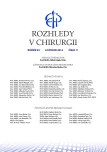Pilonidal sinus – diagnosis at the intersection of general and plastic surgery
Authors:
F. Pazdírek 1; M. Kouda 1; Z. Jech 1; L. Frajer 2; J. Hoch J 1
Authors‘ workplace:
Chirurgická klinika 2. LF UK a FN Motol, přednosta: prof. MUDr. J. Hoch, CSc.
1; Oddělení plastické chirurgie, Chirurgická klinika 2. LF UK a FN Motol, vedoucí lékař: MUDr. R. Kufa
2
Published in:
Rozhl. Chir., 2014, roč. 93, č. 11, s. 545-548.
Category:
Original articles
Overview
Introduction:
Pilonidal sinus predominantly affects young patients. Improper treatment results in long-term restrictions in everyday life and incapacity for work. The aim of the study was to find out what the results and current treatment options of pilonidal sinus are. Material and methods: This is a retrospective analysis of 67 patients treated at the Department of Surgery of the Second Medical Faculty of Charles University and Motol Hospital in the period 2010−2013. We evaluated the type of surgery and infectious complications in the wound, as well as age, sex, BMI, smoking, employment of the patients, duration of wound drainage, length of hospital stay, time required to complete healing of the surgical wound, the surgeon’s erudition and disease recurrence. Results: 50 (75%) patients underwent primary closure in the midline, Limberg flap was used in 15 (22%) patients. In 2 (3%) patients, the wound was left without suture. In the group of patients who had not undergone flap reconstruction, secondary wound healing occurred in 20 (40%) patients. In the group of patients where flap reconstruction was used, secondary healing occurred in 3 patients (20%). Relapse of the disease within one year occurred in the group of patients with primary suture in the midline in 4 (8%) patients; other patients had no recurrence. Conclusion: According to our experience as well as literary data, the treatment of choice is the extirpation of the sinus with primary suture beyond the midline using a flap reconstruction technique. Key words: pilonidal sinus − flap reconstruction − complication
Sources
1. Parades V, et al. Pilonidal sinus disease. J Visc Surg 2013;150:237−47.
2. McCallum I, et al. Healing by primary closure versus open healing after surgery for pilonidal sinus: systematic review and meta-analysis. BMJ 2008;19;336(7649):868−871.
3. Al-Khamis A, et al. Healing by primary versus secondary intention after surgical treatment for pilonidal sinus. Cochrane Database Syst Rev 2010;1:CD006213.
4. Horwood J, et al. Primary closure or rhomboid excision and Limberg flap for the management of primary sacrococcygeal pilonidal disease? A meta-analysis of randomized controlled trials. Colorectal Dis 2012;14:143−151.
5. Kaya B, et al. Modified Limberg transposition flap in the treatment of pilonidal sinus disease. Tech Coloproctol 2012;16:55−59.
6. Akin M, et al. Comparsion of the classic Limberg flap and modified Limberg flap in the treatment of pilonidal sinus disease: a retrospective analysis of 416 patients. Surg Today 2010;40:757−762.
7. Anderson J, et al. Day-case Karydakis Flap for pilonidal sinus. Dis Colon Rectum 2007;51:134−138.
8. Bessa S, et al. Comparison of short-term results between the modified Karydakis flap and the modified Limberg flap in the management of pilonidal sinus disease: a randomized controllet study. Dis Colon Rectum 2013;56:491−498.
9. Guner A, et al.Limberg flap versus Bascom cleft lift techniques for sacrococcygeal pilonidal sinus: prospective, randomized trial World J Surg 2013;37:2074−2080.
10. Can M, et al. Multicenter prospective randomized trial comparing modified Limberg flap transposition and Karydakis flap reconstruction in patients with sacrococcygeal pilonidal disease. Am J Surg 2010;200:318−327.
11. Fatih A, et al. Comparsion of the limberg flap with the V-Y flap technique in the treatment of pilonidal disease. J Korean Surg Soc 2013;85:63−67.
12. Milone, et al . The role of drainage after excision and primary closure of pilonidal sinus: a meta-analysis, Tech Coloproctol 2013;17:625−630.
13. Sievert H, et al.The influence of lifestyle (smoking and body mass index) on wound healing and long-term recurrence rate in 534 primary pilonidal sinus patients, Int J Colorectal D 2013;28:1555−1562.
14. Girgin M, et al. Minimally invasive treatment of pilonidal disease: crystallized phenol and laser depilation. Int Surg 2012;97:288−292.
15. Schneider IH, et al. Treatment of pilonidal sinuses by phenol injections. Int J Colorectal Dis 1994;9:200−202.
Labels
Surgery Orthopaedics Trauma surgeryArticle was published in
Perspectives in Surgery

2014 Issue 11
Most read in this issue
- Cerebral salt wasting syndrome (CSWS) – rare case from a surgical department
- Pilonidal sinus – diagnosis at the intersection of general and plastic surgery
- Carcinoma of the sigmoid colon in an incarcerated inguinal hernia
- Complications in Surgery
